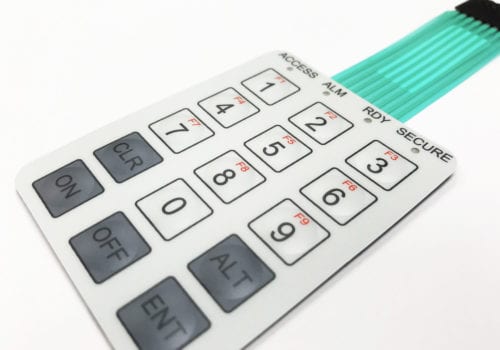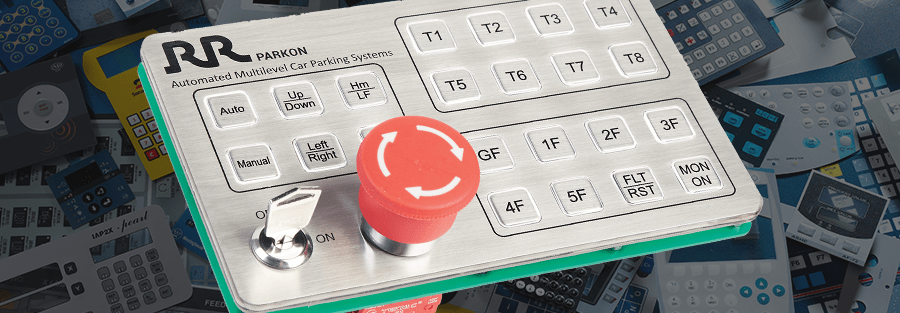Why Membrane Switches Are a Reliable Selection for Interface Solutions
Why Membrane Switches Are a Reliable Selection for Interface Solutions
Blog Article
The Ultimate Resource on Membrane Switches: Design, Functionality, and Applications
Membrane layer switches over work as an interesting junction of layout and capability, playing a crucial duty in modern interface throughout different fields. This resource unloads the vital components that add to their efficiency, consisting of visuals overlays and circuit traces, while additionally illuminating the devices behind their pressure activation. As we explore the varied applications of membrane layer switches, it ends up being evident that their versatility and resilience are vital in environments varying from medical care to customer electronics. The nuances of their layout and operational principles may reveal even deeper insights worth taking into consideration.

Comprehending Membrane Layer Switches
Membrane buttons are a kind of individual interface modern technology widely made use of in numerous digital devices, identified by their thin, adaptable design and performance. These buttons contain multiple layers that consist of visuals overlays, glue layers, and circuitry, making it possible for a effective and compact user interface for individuals. They can be discovered in home appliances, medical gadgets, and commercial control panels, giving a reputable approach for individual interaction.
Among the main advantages of membrane switches is their capacity to resist contaminants such as dirt and dampness, making them suitable for environments where toughness is essential. Their inconspicuous design enables seamless assimilation right into different applications, while the customizable visuals overlays boost individual experience by providing clear aesthetic comments. In addition, membrane buttons can accommodate a variety of innovations, such as responsive responses and backlighting, additional enhancing their usability.
The manufacturing process for membrane switches normally entails display lamination, die-cutting, and printing strategies, making certain precision and consistency in production. Generally, membrane layer switches stand for a reliable and flexible service for modern digital gadgets, combining functionality with visual charm in customer interface layout.
Trick Parts and Layout Aspects
A variety of essential elements and design components integrated to create an effective membrane button. At the core, the graphic overlay serves both aesthetic and functional functions, providing an user-friendly user interface while shielding internal elements from ecological aspects. The selection of materials, commonly polyester or polycarbonate, affects resilience and responsive comments.
Below the overlay, the glue layer makes certain the button sticks firmly to the substrate, which can be plastic, glass, or steel. The spacer layer is crucial, as it keeps the required void between the overlay and the circuit layers, enabling efficient actuation. Membrane Switches. Circuit traces, typically made from conductive ink or adhesive, are printed on a flexible substratum, allowing electric signals to be sent when stress is used
Style factors to consider additionally consist of the plan of responsive domes or embossing that supply physical comments to the user, boosting the total experience. In addition, the design and spacing of the switches need to be enhanced for ease of use, making certain that customers can browse the interface without browse this site effort. In general, these components and layout aspects function synergistically to create a trustworthy, practical membrane layer switch customized to certain applications.
Capability and Procedure System
At the heart of effective functionality for membrane changes lies their functional mechanism, which facilitates customer interaction via a basic yet effective layout. These switches operate the principle of pressure activation, where an individual applies pressure to a designated area of the switch (Membrane Switches). This activity presses the layers of the switch, completing an electric circuit that sends a signal to the linked device
The construction usually includes a leading graphic layer, a sticky spacer layer, and a bottom circuit layer, which jointly develop a robust interface. When pressure is applied, the leading layer collapses against the bottom circuit layer, enabling conductive traces to attach. This layout not just enables clear tactile responses yet also makes sure longevity and dependability, as the switches are commonly resistant to dirt and dampness.
Furthermore, the flexibility of membrane changes permits integration with different technologies, consisting of LED indicators and microcontrollers, improving their capability. By supplying a streamlined user interface that lessens mechanical wear, membrane layer switches remain a preferred selection in applications ranging from consumer electronic devices to industrial devices, guaranteeing ideal efficiency and user satisfaction across diverse atmospheres.
Sorts Of Membrane Layer Buttons

Another substantial classification is brightened membrane switches, which incorporate backlighting to enhance presence in low-light conditions. These buttons are usually used in control panels and control panels where clear visibility is essential.
Moreover, there are personalized membrane layer switches designed to fulfill details dimensional, visual, and useful needs. These customizations can consist of special shapes, shades, and layouts, enabling smooth combination right into various devices.

Applications Throughout Various Industries
How do membrane switches boost directory capability throughout varied sectors? In the clinical market, membrane buttons play an important role in tools such as analysis equipment and client tracking systems, where reliability and simplicity of cleansing are critical.
In the automobile market, membrane buttons are generally used in dashboards and control panels, providing instinctive controls that enhance motorist security and benefit. The see here consumer electronic devices sector additionally gains from their personalized and lightweight features, making it possible for smooth styles for smartphones and home devices.
Moreover, membrane switches find applications in industrial automation, where they contribute to efficient machinery procedure and tracking systems. Their resistance to dirt and wetness ensures performance popular conditions (Membrane Switches). Additionally, the food and drink market employs membrane buttons for tools control, where health and toughness are essential
Verdict
In conclusion, membrane layer switches over stand for a crucial development in individual interface modern technology, defined by their one-of-a-kind style and capability. The adaptability of membrane changes promotes their application across varied industries, from clinical gadgets to customer electronics.
Membrane layer switches over serve as an intriguing junction of style and functionality, playing a critical role in modern user interfaces across various markets.Membrane switches are a type of individual interface technology commonly used in different digital gadgets, identified by their thin, adaptable layout and performance.At the heart of efficient functionality for membrane changes lies their functional system, which promotes user communication through a straightforward yet efficient layout. These switches operate on the concept of pressure activation, where a customer uses pressure to an assigned location of the switch.In verdict, membrane layer switches over stand for a critical innovation in user interface innovation, identified by their special design and functionality.
Report this page